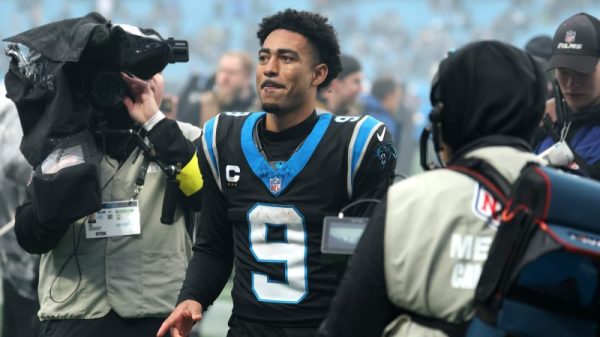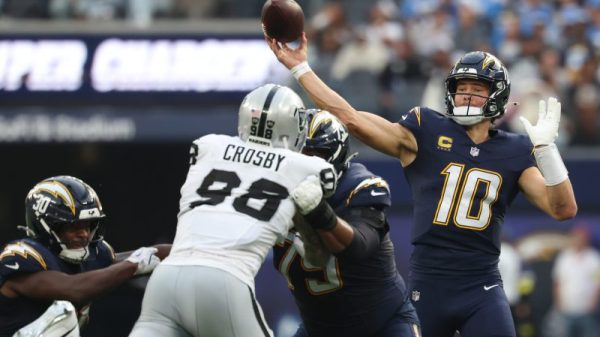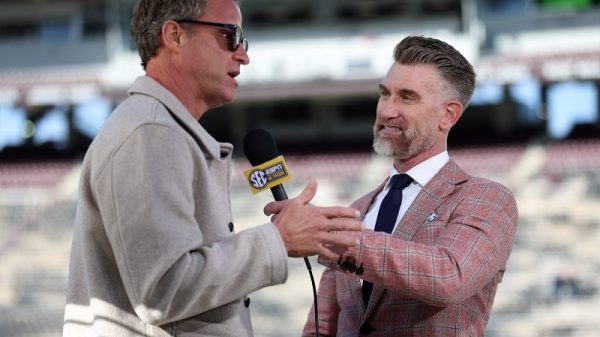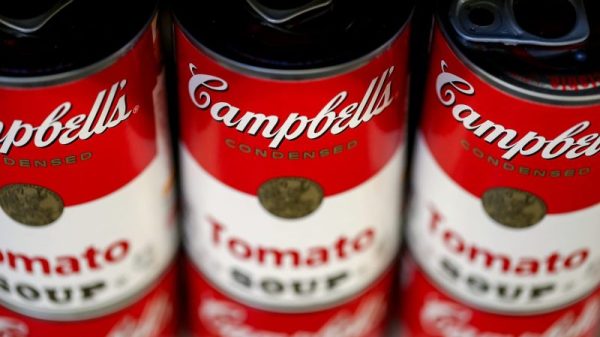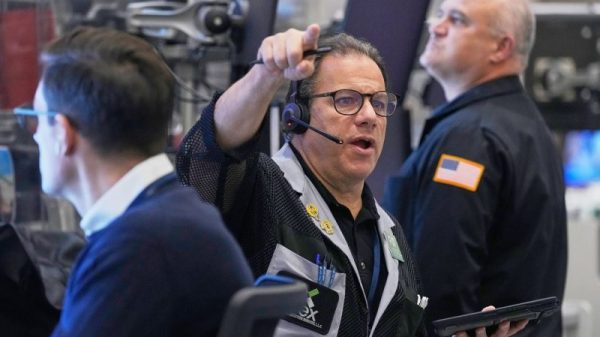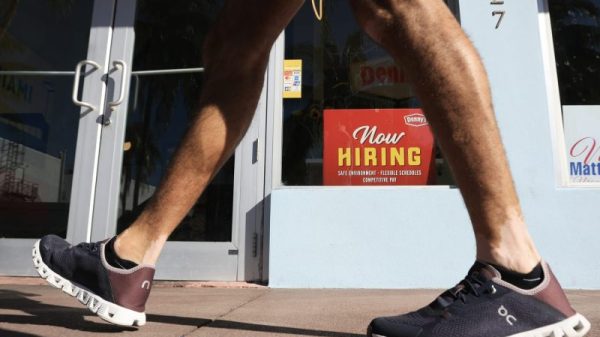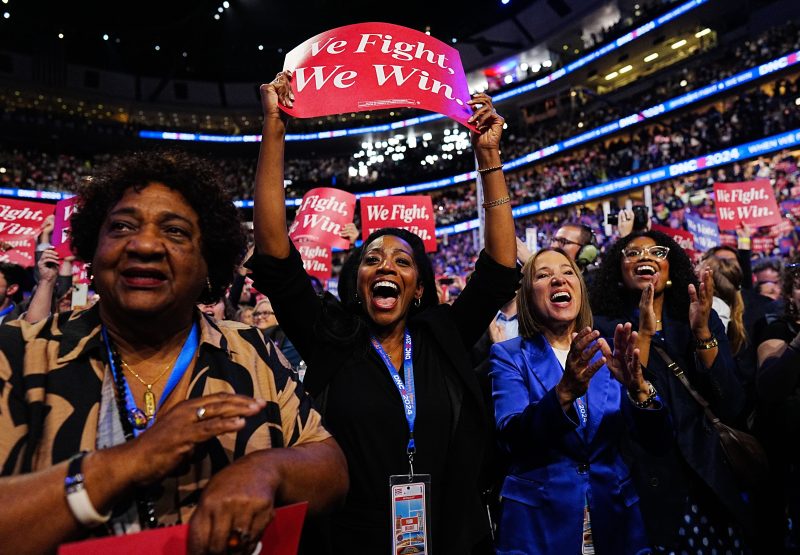CHICAGO — Kamala Harris concluded her first speech of the Democratic National Convention on Monday with what has become a familiar mantra: “When we fight,” she said, “we win!”
As Democratic National Committee chair Jaime Harrison spoke that same day, he nodded toward the line to rile up the crowd. “And believe me,” he said, “when we fight, we win.”
Steve Kerr, the head coach of the Golden State Warriors, wrapped up his speech with the same phrase.
“When we fight, what happens?” he asked to the familiar shouts back. “And we are going to win this thing together.”
All campaigns rally behind certain phrases that become inextricably linked to a candidate. Harris did not coin the phrase: It’s been used for years, and she’s only adopted it recently. But it has become one of her signature lines.
She included it in her first campaign video, behind the strains of Beyoncé singing “Freedom.” She said it as she wrapped up her first visit to the campaign headquarters in Wilmington, Del., to greet the Biden staffers that had become hers. And now it’s written in big bold letters on her campaign website.
Political slogans date back centuries, and they have long moved American voters and defined elections. In 1840, William Henry Harrison used banners and songs with a catchy, “Tippecanoe and Tyler, too” as a reference to Harrison’s role in the Battle of Tippecanoe and his running mate, John Tyler. Herbert Hoover defined his 1928 campaign with “A chicken in every pot and a car in every garage,” and Dwight D. Eisenhower’s simple slogan — “I like Ike” — helped him win a 1952 landslide.
Hillary Clinton cycled through a number of different slogans before settling on “Stronger together.” Donald Trump is most identified with “Make America Great Again,” but Republican crowds have also rallied around slogans like “Drill baby drill” and “Build the wall.” They used to chant, “Lock her up” as a reference to Clinton.
Obama used “Yes we can.” But this year, the national mood is more combative.
After Trump survived an assassination attempt last month, he stood up, pumped his fist and yelled, “Fight.” A few days later, Donald Trump Jr. led the Republican convention in chants of “Fight! Fight! Fight!” Clinton’s signature campaign song in 2016 was Rachel Platten’s “Fight Song” and Sen. Elizabeth Warren (D-Mass.) used “Dream big, fight hard” during her campaign for the 2020 presidential nomination.
At this week’s convention, Democrats see the phrase as an inclusive call to action that asks supporters to link arms in solidarity.
Greg Jobin-Leeds, who co-wrote a 2016 book titled “When We Fight, We Win: Twenty-First-Century Social Movements and the Activists That Are Transforming Our World,” traces the first use of the phrase to City Life/Vida Urbana, a Boston-based social justice organization that has its roots in civil rights and antiwar movements and used the chant in anti-eviction efforts over the past several decades.
After Jobin-Leeds’s book came out, he set up a Google alert for the phrase to keep track of other uses of it. The musician Rev. Sekou released an album and a song by the same name in 2019. But Jobin-Leeds, by his own account, is getting way more Google alerts now.
“Part of the sentiment is we don’t always win the legislation or the bill or the labor strike or the immigrant policy that we’re looking for,” he said. “But you always win your humanity when you fight. And if you don’t fight and you just roll over, you’ve already lost.”
The phrase uses “we” twice, and he said it’s a key concept in building a collective rally behind a cause.
“You build a ‘we’ during the fight,” he said. “Whether fighting for tenants’ rights or teachers having adequate pay, you build a unified we. And you build your self-confidence and your ability to fight. It’s in the fighting that you already win.”
Jobin-Leeds has been intrigued to see Harris adopt the phrase, but has mixed feelings about it being used in mainstream politics.
“Generally it’s been a phrase of the underdog — of the immigrant and the tenant and not the billionaire,” he said. “It’s interesting to see it in a political campaign which is more within the Democratic establishment.”
Delegates here have quickly embraced the phrase, learning to complete the sentence and join along in the chant. Deloris Rome Hudson, a retired teacher from Ohio, said she loved the slogan.
“Often, in order to achieve what you want — that’s the fight,” she said. “You have to get people behind you to be successful. That’s what this is all about.”
Terry McAuliffe, the former governor of Virginia and longtime Democratic Party official, called the slogan “a call to action for the grass roots.”
“Everybody’s unified and jazzed up here. But it’s going to be a tough slog,” he said. “When we fight, everybody’s gotta get out there. We’ve got to knock on doors, make the phone calls. We can’t take anything for granted. Because they’re going to fight hard on the other side.”
“But the fight is to energize people,” he added. “You can’t sit home and complain. You want to get in the game? Go fight. Make calls, knock on doors. That’s what that means.”
In the past, the phrase has been used as a rallying cry in the labor movement. Jesse Jackson used it during a rally in Wisconsin in 2011. Commentator Van Jones mentioned it in a column in 2012. And the slogan was the theme for the NAACP’s national gathering in 2019. Harris attended that convention as part of her 2020 Democratic primary campaign.
Harris used variations of “fight” during that race, but her campaign slogan was “For the People.”
Earlier in her vice presidency, Harris had a routine of ending speeches with a riff on common Democratic principles such as freedom and equality, reproductive rights and collective bargaining. “When we know what we stand for, then we know what we fight for,” she’d say.
Over time, she also tacked on the next line: “And when we fight, we win.” It was an attempt, Harris aides say, to connect her childhood going to civil rights rallies in a stroller with today’s political battles. During the 2022 midterms, she began regularly taking up the phrase that would become her signature.
“We know what we stand for. We know when we fight, we win,” she told an audience at a Greater Boston Labor Council breakfast in September 2022. She said the phrase again that month at a Democratic National Committee meeting, again as she rallied Democrats in Texas and Illinois, and again at a Minnesota fundraiser for Gov. Tim Walz, who two years later would accompany her atop the party ticket.
In 2023, the phrase became her mantra when talking about abortion rights or gun control. She said it at rallies in Michigan and Wisconsin, in Indianapolis and Atlanta. She used it when introducing Walz as her running mate.
Walz, in his introductory video, concluded with: “Like she says, when we fight, we win”
And on Wednesday night, he used it as the climax of his speech accepting the vice-presidential nomination, engaging in a call and response with the crowd.
“As the next president of the United States always says: When we fight?” Walz said.
The crowd chanted in unison: “We win!”
“When we fight?”
“We win.”
“When we fight?”
“We win.”
“Thank you. God bless.”






